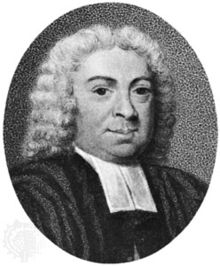Johann Jacob Dillen
Johann Jacob Dillen ( Dillenius ) (born December 22, 1684 in Darmstadt , † April 2, 1747 in Oxford ) was a German botanist . Its official botanical author's abbreviation is “ Dill. ".
Life
The son of a doctor studied medicine at the University of Giessen and received his doctorate in 1719. In the same year he published an extensive Flora von Gießen , in which he (similar to Heinrich Bernhard Rupp in his Flora von Jena ) treated not only the phanerogamous plants but also the cryptogams . He not only described numerous new species, but also endeavored, especially in the case of mushrooms , to differentiate between genera, several of which were adopted by Linnaeus .
Of the 200 species of moss that Dillenius listed in his Flora von Gießen, 140 were not known until then. Of the 160 species of mushrooms , 90 were new.
On June 24, 1713 Dillenius with the academic surname Glaucias I was elected member ( matriculation no. 301 ) of the Leopoldina . In 1721 he accepted an invitation from the botanist William Sherard to England, where, among other things, he dealt with the extensive plant collections of his host. With Sherard, Dillenius also undertook extensive trips through the west of England and Wales.
Sherard, who died in 1728, had bequeathed his plant collection and library and a substantial sum of money for the establishment of a botanical chair at Oxford University . Dillenius was the first professor to be appointed to this post for life.
Dillenius was in lively scientific contact with his famous contemporaries Albrecht von Haller and Carl von Linné .
Honors
Carl von Linné named the genus Dillenia of the plant family Dilleniaceae in his honor .
Works
- Catalogus plantarum sponte circa Gissam nascentium (1719)
- Hortus Elthamensis (1732, 2 vol. With 324 copper plates)
- Historia muscorum (1741; with 85 copper plates)
The latter is considered Dillenius' main work, which for the first time contains more detailed descriptions of deciduous mosses .
swell
- Helmut Dolezal: Dillenius, Johann Jakob. In: New German Biography (NDB). Volume 3, Duncker & Humblot, Berlin 1957, ISBN 3-428-00184-2 , p. 718 ( digitized version ).
- Karl Mägdefrau : history of botany . Gustav Fischer Verlag , Stuttgart 1992, ISBN 3-437-20489-0 .
- Ilse Jahn : history of biology . Spectrum Academic Publishing House , Heidelberg / Berlin 2000, ISBN 3-8274-1023-1 .
- Meyers Konversationslexikon. 1888-1889.
Web links
- Member entry of Johann Jakob Dillenius at the German Academy of Natural Scientists Leopoldina , accessed on May 14, 2018.
- Author entry and list of the plant names described for Johann Jacob Dillen at the IPNI
- Entry on Dillenius; Joannes Jacobus (1687-1747) in the Archives of the Royal Society , London
- Johann Jakob Dillenius 1684-1747. An exhibition in the Giessen University Library for the 300th birthday . University Library, Giessen 1984 ( digitized version )
Individual evidence
- ^ Carl von Linné: Critica Botanica . Leiden 1737, p. 92.
- ↑ Carl von Linné: Genera Plantarum . Leiden 1742, p. 253.
| personal data | |
|---|---|
| SURNAME | Dillen, Johann Jacob |
| ALTERNATIVE NAMES | Dillenius, Johann Jacob; Dillenius, Johann Jakob; Dillen, Johann Jakob |
| BRIEF DESCRIPTION | German botanist |
| DATE OF BIRTH | December 22, 1684 |
| PLACE OF BIRTH | Darmstadt |
| DATE OF DEATH | April 2, 1747 |
| Place of death | Oxford |
